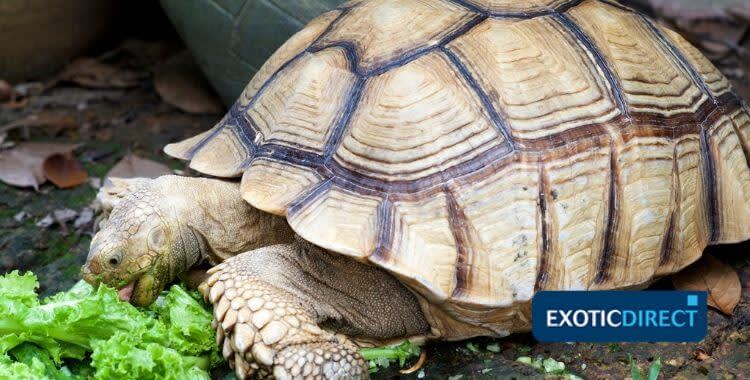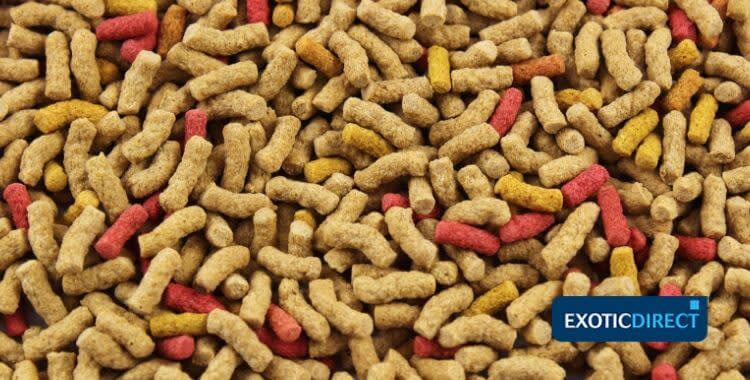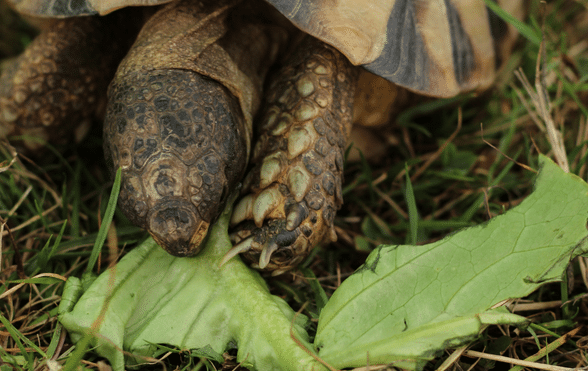Should you be feeding your tortoise pellets and why? And what mistakes have manufacturers made in the past? Read our guest writer…
Is your tortoise insured? Get a quote for £2,500 of vet fees, death and theft cover. Vet fee cover only also available | We’ve been insuring exotic pets since 1996 | Check out our customer reviews on Feefo.
Do tortoises need dried tortoise food?
The answer is yes. Pellets are generally considered to be a useful addition to a tortoise’s natural diet suitable for use at times when other food may be harder to find and nutritionally poor as well.
Factors that are of key significance include the type of tortoise that you keep, as well as its age and state of health.
In the case of Mediterranean species and the African sulcata tortoise, which are herbivorous in their feeding habits, their diet needs to be based primarily around green stuff.
While suitable foods are readily available for them in summer, it can be much harder to find an adequate supply in winter.
Shop-bought greens, grown hydroponically, may have much lower mineral levels, particularly in terms of calcium, compared with dandelions growing outdoors in your garden. You simply can’t tell the nutritional value of this type of food by looking at such plants.
So pellets provide the advantage of additional nutritional content.
The case for using pellets as a dietary supplement is also greater during the winter months than in summer for tropical tortoises that do not hibernate, as well as young Mediterranean hatchlings that are being kept awake at this stage.
 Tortoises need fresh greens and pellets can compliment these as part of a complete diet.
Tortoises need fresh greens and pellets can compliment these as part of a complete diet.
Jump to: What pellets should tortoises eat? | Pellet nutrient content | Past problems with pellets | Adding water to pellets
What pellets should tortoises eat
Grassland pellets are suitable for Mediterranean and sulcata tortoises. Red-foots, yellow foots and hingebacks need a forest tortoise pellet food.
Tortoise pellet nutrient content
There are various brands of tortoise pellet available today and those from reputable brands all have requisite high fibre levels in excess of 20%, as you can confirm from studying the nutritional breakdown of the product on the packaging.
Some of these new formulations are also soft, to make them more palatable. They have a much wider range of ingredients compared with cobs, which should be viewed as a supplement to pellets and simply offer your pet more variety, in terms of a dry food component in its diet.
 Pellets should be high in fibre – over 20%.
Pellets should be high in fibre – over 20%.
The problems with pellets in the past
With the benefit of hindsight today, the manufacturing process of the early tortoise pellets was less than ideal and caused potential problems.
Cereals were used as a major ingredient. Maize or wheat, for example, was ground down into small particles to create a food of even consistency, so the ingredients could then be extruded (effectively forced) through a perforated plate, called a die. This enabled the production of pellets of a standard size.
When a tortoise ate pellets of this type, the food broke down in its digestive system into much smaller particles than would be the case if it was eating a standard diet of green stuff.
As a result, the fibre content of this type of pelleted diet was much lower than normal. This in turn slowed the movement of the food through its digestive system.
The effective surface area of the food was also exposed to digestive enzymes and microbes, meaning that a higher percentage of the nutrients actually ended up being absorbed across the intestinal wall into the tortoise’s body.And because the fibre content was relative low the tortoise continued to eat more of this type of pellet because it still felt hungry.
As a result, a tortoise fed on this type of pelleted diet received a much higher nutritional intake than normal.
In the case of a young, growing tortoise the most obvious sign was growth abnormalities as seen in the shell. This was particularly serious given that these deformities are life-long.
As previously mentioned manufacturers recognized these problems, and have devised pellets with a higher fibre content.
If your tortoise begins to develop shell deformities you should always speak to your vet.
Tortoise cobs
Cobs for tortoises are comprised exclusively of dry plant matter, such as hay and dandelion, and so offer a good source of natural fibre.
This new type of tortoise food has been created by taking natural food plants and chopping them up moulding them into what are called cobs.
These chunks of food can be easily distinguished from pellets (although both types do tend to be called pellets), as they are much larger in size, and not of an even shape.
Cobs may contain up to almost 30 different weeds and grasses, offering a more varied diet to that extent, as well as high fibre levels.
Cobs are therefore much more akin to a tortoise’s natural diet, in terms of their ingredients, containing long and relatively coarse pieces of vegetation.
Some of these cobs are now being supplemented too, with key ingredients such as calcium and also vitamin D3.
Tortoises seek out food primarily by scent, although sight also plays a part.
The addition of appealing natural plant scents to these prepared foods is designed to attract the tortoises’s attention to them.
The fact that cobs are dry is less significant, because in the hot summers of the Mediterranean or Africa, lush plants become an increasing rarity, resulting in tortoises being forced to eat more dry matter.
Is your tortoise insured? Get a quote for £2,500 of vet fees, death and theft cover. Vet fee cover only also available | We’ve been insuring exotic pets since 1996 | Check out our customer reviews on Feefo.
Should I add water to tortoise pellets?
When introducing tortoises to high fibre pellets or cobs, soak this food in a small amount of water beforehand.
This will cause the pellets or cobs to swell and become softer, but do not submerge them so they break up. Also, remember that after being moistened, they will deteriorate quite rapidly and become mouldy.
Only offer a small quantity corresponding to what your pet will eat rapidly, removing any that are not consumed after a few hours.
There is no guarantee that your tortoise will take a complete food whether in the form of pellets or cobs.
Some individuals will accept this type of food very readily, even preferring it to fresh food. On the other hand, others will persist in ignoring it in spite of ongoing attempts to persuade them to eat it.
Try mixing this type of food in amongst other food to encourage their interest. Avoid buying a large tub of pellets or cobs at the outset though, in case your pet refuses to eat them. Furthermore, be careful of purchasing by mail order, if you do not know the ‘use by’ date for the product batch, as it will have to be discarded once this stage is reached.
Store the pellets in a cool, dry environment, out of direct sunlight, and keep the lid in place, to maximise the potency of their vitamin content.
Learn more about diet in our article Tortoise food and diet advice
Key points to remember with pellets
-
- Don’t rely mainly on pellets or cobs for your tortoise. A natural diet is best, but pelleted food can add extra variety and also helps at times when other food is in short supply.
-
- Read the ingredients carefully. Avoid those with high carbohydrate levels, made from cereals like wheat and maize. A high fibre level is vital too, along with a relatively low percentage of protein.
Check whether the food you choose offers a complete diet, in terms of vitamins and minerals – you may need to cut back on the use of supplements, to avoid the risk of overdosing under these circumstances.
-
- Obtain the right type of pellet for your particular species of tortoise: grassland pellets are suitable for Mediterranean and sulcata tortoises. Red-foots, yellow foots and hingebacks need a forest tortoise food
-
- Soak the pellets first, and only offer a limited quantity. Remove any left uneaten by the end of the day
-
- Make dietary changes slowly, mixing pelleted food in alongside other food
- Keep a watch on your’s pet’s appetite and shell growth. If any abnormalities start to appear, then seek advice from a specialist reptile vet without delay, reviewing the diet that you are offering to your pet at this stage.
Is your tortoise insured? Get a quote for £2,500 of vet fees, death and theft cover. Vet fee cover only also available | We’ve been insuring exotic pets since 1996 | Check out our customer reviews on Feefo.
David Alderton is our guest writer. As well as a reptile expert he’s also the editor of Practical Reptile Keeping and a published author.

